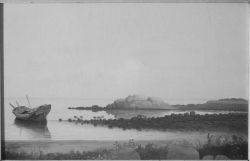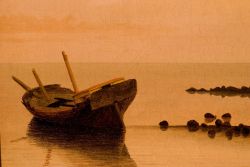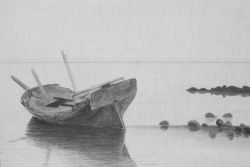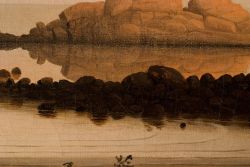An online project under the direction of the CAPE ANN MUSEUM
Catalog entry
inv. 37
Brace's Rock
Brace's Rock, Eastern Point
1864 Oil on canvas 10 x 15 in. (25.4 x 38.1 cm) No inscription found
|
Commentary
This version may have been the first painting of the series, according to recent research published by Marcia Steele and Travers Newton of the Cleveland Museum of Art. The theory is that in this painting, the height of the horizon line relative to the bluff on the right connecting to Brace’s Rock matches the field sketch. In the other two versions of this composition (see below) the horizon line has been lowered by about 1.5 centimeters (in the Private collection version) and 3 centimeters (in the National Gallery painting). Lowering the horizon line serves to accentuate the height and compositional presence of Brace’s Rock itself, leading to the theory that Lane painted the Cape Ann Museum version first, then wanted the rock to have more presence and progressively lowered the horizon line in the two subsequent versions.
Like many other nineteenth-century painters, Lane used the device of the wrecked ship, generally accepted as a symbol of the transient nature of life. In the Brace’s Rock series this device is particularly effective in creating the sense of melancholy so palpable in these paintings, but one cannot also help but notice how beautifully these shipwrecked hulls are conceived and painted. Lane is once again finding a way to lovingly shape and paint his favorite subject, whatever its use in the overall composition.
The foreground details of these three paintings are all different. This version shows Lane’s typically beautiful mix of shoreline bushes and grasses interspersed with granite boulders fronting the crescent beach. Some of the leaves have turned red and yellow, corresponding to the late summer season and also enlivening the dark greens and grays of the foreground shadow. Note the differences in the three foreground details shown below.
The composition is made up of three horizontal lines: the foreground, the black rock reef, and Brace’s Rock itself. The foreground beach arcs around to the reef mirrored by the small waves coming ashore. This arc leads the eye out along the reef and to the stranded boat with the broken masts. Note the yellow-and-red deckhouse at the vessel's stern to brighten up the gray and brown of the wreck. Brace’s Rock glows pink and orange in the late afternoon light, and note how Lane has accentuated its color by using a muted gray for the adjacent rocks. The rich grays and browns of the reef also serve as a dramatic counterpoint to the warm colors of the rock. The shape of the rock has been crowned with a cumulus cloud just above for further emphasis. It is a deceptively simple and humble painting of a modest subject. Lane's work expresses a quiet but powerful emotion.
– Sam Holdsworth
Related Work in the Catalog
Supplementary Images
Provenance (Information known to date; research ongoing.)
Exhibition History
Traveled to: Colby College Art Museum, Waterville, Maine, 30–6, 1966.
Traveled to: Museum of Fine Arts, Boston, Mass., 5–31, 1988.
Traveled to: Spanierman Gallery, New York, N.Y., 4–1, 2007.





The Braces Rock Series
The Brace’s Rock series of paintings is thought to comprise Lane’s last dated oils, painted in the fall and winter of 1863–64, not long before his death in August of 1865. Paintings of unusual peace and harmony, they present a fitting finale to Lane’s evolution as a painter. Each one is as much an ode to the bittersweet recollections of a late summer afternoon as it is a depiction of a familiar Gloucester landmark. Lane accomplished this without abandoning any of his fidelity to accurate depiction of place, season, and time of day.
Numerous writers have noted the symbolism of the decaying hull foundered on the rocks and the ebbing tide as markers of Lane's awareness of his own mortality. The paintings evoke an inescapable feeling of ennui in the preternatural calm of the sea, the limpid humidity of the still atmosphere, and the pink glow of the late afternoon sun off Brace's Rock. Knowing that these are Lane's last paintings, done in failing health in his studio throughout the course of his last winter, the viewer cannot escape the feeling that these paintings were a eulogy to his beloved Gloucester shoreline. Read on »